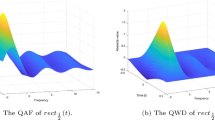Abstract
The radar ambiguity function plays a central role in the theory of radar signals. Its absolute value (¦A(u)¦) measures the correlation between the signal u emitted by the radar transmitter and its echo after reaching a moving target. It is important to know signals that give rise to ambiguity functions of given shapes. Therefore, it is also important to know to what extent ¦A(u)¦ determines the signal. This problem is called the “radar ambiguity problem” by Bueckner [5]. Using methods developed for phase retrieval problems, we give here a partial answer for some classes of time limited (compactly supported) signals. In doing so, we also obtain results for Pauli's problem; in particular, we build functions that have infinitely many Pauli partners.
Similar content being viewed by others
References
Altes, R.A. (1973). Some invariance properties of the wide-band ambiguity function,J. Acoustical Soc. Am.,53, 1154–1160.
Auslander, L. and Gretner, I. (1990). Wide-band ambiguity functions and theax+b group, InSignal Processing Part I: Signal Processing Theory, Vol. 22 ofI.M.A. Vol. in Math and its Appl., 1–2.
Auslander, L. and Tolimieri, R. (1985). Radar ambiguity functions and group theory,SIAM J. Math Anal.,16, 577–601.
Barakat, R. and Newsam, G. (1984). Necessary conditions for a unique solution to two dimensional phase recovery,J. Math. Phys.,25, 3190–3193.
Bueckner, H.F. (1967). Signals having the same ambiguity functions, Technical Report 67-C-456, General Electric, Research and Development Center, Schnectady, NY.
Corbett, J.V. and Hurst, C.A. What is needed to determine a state, manuscript.
Corbett, J.V. and Hurst, C.A. (1978). Are wave functions uniquely determined by their position and momentum distributions ?J. Austral. Math. Soc. Ser. B,20, 182–201.
de Buda, R. (1970). Signals that can be calculated from their ambiguity function,IEEE Trans. Information Theory, IT16, 195–202.
Friedman, C.N. (1989). Some remarks on Pauli data in quantum mechanics,J. Austral. Math. Soc. Ser. B,30, 298–303.
Grünbaum, F.A. (1984). A remark on the radar ambiguity function,IEEE Trans. Information Theory,30, 126–127.
Hurt, N.E. (1989).Phase Retrieval and Zero Crossing (Mathematical Methods in Image Reconstruction), Math. and Its Appl., Kluwer Academic Publisher, Amsterdam.
Ismagilov, R.S. (1996). On the Pauli problem,Funksional Anal i Prilozhen,30, 82–84, (in Russian), translation inFunct. Anal. Appl.,30, (1996), 138–140.
Janssen, A.J.E.M. (1992). The Zak transform and some counter-examples in time-frequency analysis,IEEE Trans. Information Theory,38, 168–171.
Katznelson, Y. (1976).An Introduction to Harmonic Analysis, Dover, New York.
Klibanov, M.V., Sacks, P.E., and Tikhonravov, A.V. (1995). The phase retrieval problem,Inverse problems,11, 1–28.
Pauli, W. (1932). Die allgemeinen Prinzipien der Wellenmechanik,Handbuch der Physik,17
Reichenbach, H. (1944).Philosophic Foundations of Quantum Mechanics, University of California Press, Berkeley.
Rosenblatt, J. (1984). Phase retrieval,Comm. Math. Phys.,95, 317–343.
Stefanescu, I.S. (1985). On the phase retrieval problem in two dimensions,J. Math. Phys.,26, 2141–2160.
Swick, D.A. (1966). An ambiguity function independent of assumption about bandwidth and carrier frequency, Technical report, NRL Repport.
Titchmarsh, E. (1939).The Theory of Functions, 2nd ed., Oxford University Press, London.
Vogt, A. (1978). Position and momentum distributions do not determine the quantum mechanical state, In Marlow, A.R., Ed.,Mathematical Foundations of Quantum Theory, Academic Press, 365–372.
Walter, A. (1963). The question of phase retrieval in optics,Opt. Acta,10, 41–49.
Wilcox, C.H. (1991). The synthesis problem for radar ambiguity functions, Technical Report 157,MRC Tech. Summary Report. Republished inRadar and Sonar, Part I, Vol. 32, I.M.A. Vol. in Math. and its Appl., 229–260.
Woodward, P.M. (1953).Probability and Information Theory with Applications to RADAR, Pergamon, New York.
Author information
Authors and Affiliations
Additional information
Communicated by William Moran
Rights and permissions
About this article
Cite this article
Jaming, P. Phase retrieval techniques for radar ambiguity problems. The Journal of Fourier Analysis and Applications 5, 309–329 (1999). https://doi.org/10.1007/BF01259373
Received:
Revised:
Issue Date:
DOI: https://doi.org/10.1007/BF01259373




